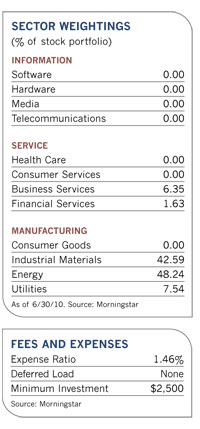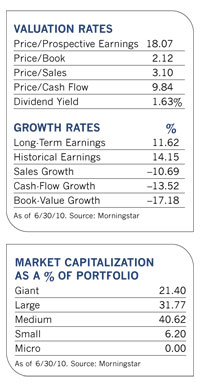"Owning a large number of commodity stocks really doesn't provide any real protection against risk because you are going to have more high-cost producers in the mix," he argues. "Across a long-term commodity cycle, those types of companies are going to destroy value." But if the number of firms is smaller, so is the turnover ratio of 34%-which is about one-third that of the fund's competitors in the natural resource space. It attests to the long investment time horizon for the kinds of companies the managers like.
Settles points out that over the long term, the stocks of low-cost producers have generated returns well in excess of their underlying commodities. "Over the last decade, annualized returns from most commodities have ranged from zero to 5%, and commodity ETF prices have pretty much followed that pattern," he says. "Over the same period, low-cost producers have generated annualized returns in the 15% to 25% range. So what you're getting with these stocks is the intrinsic value of these companies along with commodity exposure."
The fund may lag commodities over shorter time periods when natural resource prices are escalating rapidly. But Davis says the fund makes up for that in volatile or declining markets and, more important, over the commodity price cycle, when the fund's focus on managing risks can yield better returns. The fund beat the S&P GSCI Total Return Index, a diversified index of commodities, over the ten years ended December 31, 2009 by logging annualized returns of 16%, while the index returned 5%.
Another drawback, however, is that commodity companies can suffer as many big short-term fluctuations as the items they dig up. In the ten years ending December 31, 2009, the fund's annualized standard deviation was 23.71, just a tad lower than the 25.20 annualized standard deviation of the S&P GSCI Total Return Index.
Morningstar analyst Jonathan Rahbar notes that while the fund's trailing ten-year returns are well ahead of the competition and trounce the S&P Natural Resource Index's gain, its volatility "is still meaningful, so added caution is warranted when investing in any option focused on natural resources."
Furthermore, the correlation between commodities and U.S. large-cap stocks has been higher than historical averages in recent years. But Davis believes the fund is still a good diversifier and an insurance policy against inflation.
"It's also a way to participate in the growth dynamics of emerging markets without emerging market risk," he says.










